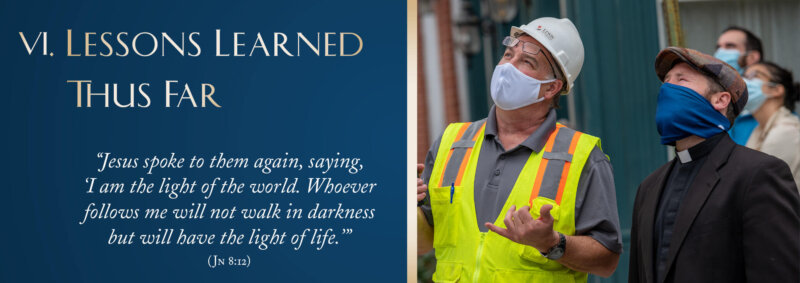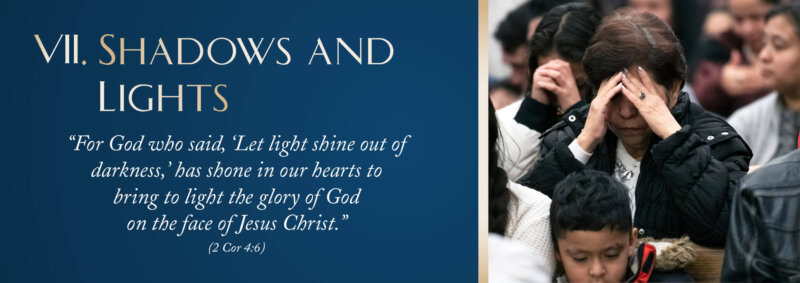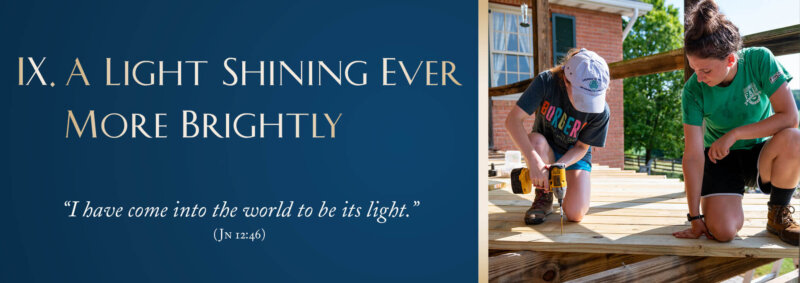A third and primary place where the light of Christ must shine brightly is our parishes. Pope Francis refers to the parish as “a family of families,” thus instructing us that the stronger and more vibrant our Catholic families are, the stronger and more vibrant our parishes will be. To be sure, parishes are “families” in an analogous sense; it means that parishioners should experience in our parish communities the characteristics of a loving family. Loving pastoral leadership can and should foster a sense of belonging and participation among parishioners, allowing the bonds of faith and charity to blossom in a wide range of ministries and outreach to those who are in need. Such a familial atmosphere helps to create unity rooted in the encounter with Jesus Christ, in reverent worship, and faith sharing. It helps to break down the fears and anxieties of those who wish to return to the practice of the faith, creates a favorable climate for dialogue and understanding, and encourages a missionary spirit. By contrast, when a parish has an “institutional” feel, it can be cold and off-putting, prompting parishioners to look elsewhere for spiritual nourishment or, sadly, to head for the exit, perhaps never to return.
Ordained Leadership
Leadership is crucial in forming warm and vibrant parish communities. I am deeply grateful to my fellow bishops, priests, and deacons who have committed themselves to the mission of evangelization in this Archdiocese. I am also aware, however, that the mission entrusted to us sometimes seems overwhelming, beyond our reach, especially in challenging times such as these. It is all too easy to grow discouraged by administrative burdens, by economic headwinds, as well as by the trenchant criticisms and the seeming indifference of many people to the Gospel message that we so urgently wish to convey. At other times, we feel as if we are alone, unsupported, either by our fellow clergy or our people. Yet, as those ordained to proclaim the Gospel, the light of Christ must shine brightly in us, and through us, onto the parish families the Church has called us to serve.
How can we ensure that the darkness of weakness and discouragement will not overcome the light of Christ planted in our hearts by the Holy Spirit at Baptism and Confirmation and renewed in us through the Sacrament of Holy Orders? The Gospel answer to that question is that we must prefer to everything else “the one thing necessary” (Lk 10:38-42), namely, daily sustained prayer in which we listen to the voice of the Lord. As you recall, when Jesus visited the home of Martha and Mary, Martha busied herself about the details of hospitality, while Mary sat with Jesus and listened to “the words of spirit and life” he spoke (Jn 6:63). Often, those of us in ordained ministry can be more like Martha than Mary. We can busy ourselves with the details of parish ministry until we grow tired and discouraged and find ourselves “out of steam.” The only way to keep ourselves young and vibrant in ministry is daily prayer in the Presence of the Blessed Sacrament. If we want to preach convincingly, exhibit pastoral love, and experience support and friendship, then we must spend an hour a day adoring the Eucharistic Lord, allowing his heart to speak to ours, making reparation for our sins, and allowing Jesus to deepen his divine friendship with us. When we spend this quiet time—away from every other distraction—we experience more profoundly Christ’s priestly love for us. The more we pray, the more the Scriptures and our Catholic Tradition come alive for us, and the more we become witnesses, not just teachers of the faith. Only if our Eucharistic faith is alive and well can we convince non-practicing Catholics to return to Holy Mass on Sunday.
Integral to the daily prayer of the ordained is the Liturgy of the Hours. We pledged to pray the Divine Office at ordination, yet sometimes this daily prayer of the Church all too readily goes by the board. Yet, what a consolation it is when we pray the Psalms attentively, allowing them to reflect Christ’s truth and love, experiencing them as a sounding board for our many moods and concerns. What a consolation it is to read and study the Scriptures continuously and to benefit from the wisdom of the great spiritual writers of the Church. Few resources enrich our ministry more than the Liturgy of the Hours.
Just as “Scripture is the soul of theology,”3 so too Scripture is the soul of preaching, evangelization, and catechesis. If we would “do the work of an evangelist” (2 Tim 4:5), then we must immerse ourselves in Sacred Scripture by carefully studying the texts on which we preach, by engaging in lectio divina, and by learning how to hear the voice of Christ throughout Scripture. Let us never underestimate the power of the inspired Word of God itself to move and open minds and hearts to the glad tidings of salvation.4
So too, as pilgrims on the road to salvation, we sometimes slip and fall. Sound spiritual direction and the fruitful reception of the Sacrament of Reconciliation are crucial. In these moments of grace, the Holy Spirit works overtime, so to speak, to “create in us a clean heart” (Ps 51), a heart that more perfectly reflects the light and love of Christ that should shine in and through us as we preach the Word, celebrate the Sacraments, and guide our parish communities in love. For many of our people, the Sacrament of Reconciliation is the gateway for their return to the practice of the faith. Our own dependence upon this Sacrament of Mercy will enable us to speak personally of its benefits in our spiritual lives, and prompt us to be as generous and as merciful as possible in administering it.
Similarly, prayer groups play an important role in supporting us in ministry. I think of the many Jesu Caritas groups in the Archdiocese and of other less formal gatherings of prayer. The Holy Father’s encyclical, Fratelli Tutti, underlined the solidarity, the fraternity that is ours in Christ Jesus, as human beings, as disciples, and indeed as deacons, priests, and bishops. We need to help one another grow in holiness and in the courage and strength needed for our mission.
Indispensable in our lives is devotion to the Blessed Virgin Mary. She accompanies us whenever we pray, for she seeks to bring forth Christ in us. She “who heard the word of God and kept it” (Lk 11:28), prays that we too will hear and abide by the Word we are to preach. Just as from the Cross Jesus entrusted his Mother Mary to John the Beloved, so too Jesus entrusts Mary to us as our spiritual Mother. May she, who witnessed the outpouring of the Holy Spirit at Pentecost, pray for a fresh outpouring of the Spirit upon us and our co-workers.
As our prayer life grows apace, some things previously shrouded become clear. One of them is our tendency—yours and mine—to overthink and overcomplicate evangelization. Perhaps we spill too much ink in describing what it is and how it should be done. As a result, evangelization may loom so large that we mistakenly conclude that it is out of reach, or is best left to younger clergy, or put solely in the hands of lay staff. However, as we grow in friendship with Jesus and as we open our hearts to the Holy Spirit, we may discern a call to use our time and energy differently, devoting less time to internal meetings and the details of administration while devoting more time to person-to-person contact with parishioners.5 This includes those who practice regularly and those who come only periodically as well as those who seem to have left forever.
For example, during this pandemic, some parishes set up phone trees with the goal of contacting each parishioner personally. In most instances, it was a joint project of parish priest, staff, and lay volunteers. The content of those conversations was simple: “How are you? What can we do to help? Anything you’d like to share?” When I was growing up, the pastor or associate pastor visited the homes of parishioners every year. Those visits lasted perhaps half an hour, but they made a deep impression on me. More than once, the parish priests asked me if I wanted to become a priest. Mom and Dad felt supported in their responsibility to care for my older brother with special needs. They used to talk about how blessed they were to have priests who knew them personally and cared for them.
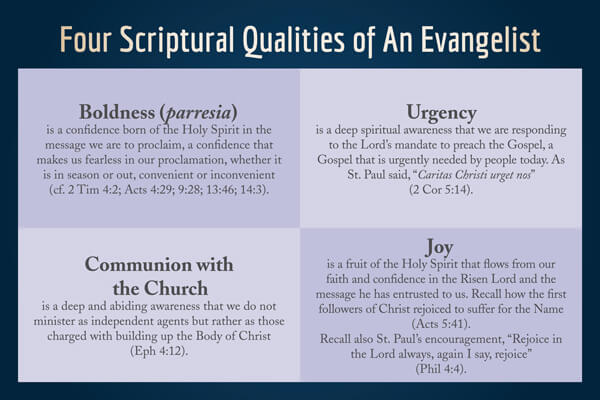 Somewhere along the way, the practice of visiting the homes of parishioners seems to have largely fallen out of favor, perhaps because it is hard to find people at home or because there are fewer clergy than previously was the case. Yet, would it not be a wonderful thing if, every year, every parishioner—active or inactive—received a personal call or perhaps an invitation to a Zoom meeting? Indeed, the more we stay in touch with parishioners and communicate with them personally, the more likely it is that they remain or become active in the life and mission of the parish. True enough, in making personal contacts, some may give us an earful or otherwise rebuff our efforts. That is why we need a healthy life of prayer and that is why we need to support one another.
Somewhere along the way, the practice of visiting the homes of parishioners seems to have largely fallen out of favor, perhaps because it is hard to find people at home or because there are fewer clergy than previously was the case. Yet, would it not be a wonderful thing if, every year, every parishioner—active or inactive—received a personal call or perhaps an invitation to a Zoom meeting? Indeed, the more we stay in touch with parishioners and communicate with them personally, the more likely it is that they remain or become active in the life and mission of the parish. True enough, in making personal contacts, some may give us an earful or otherwise rebuff our efforts. That is why we need a healthy life of prayer and that is why we need to support one another.
Lay Leadership
One of the chief responsibilities of a pastor is to form a cohesive, mission-driven team of co-workers. I am very grateful to you, the dedicated women and men, members of the laity and those in consecrated life, who serve on parish staffs as evangelizers, catechists, educators, ministers of charity and justice, and so much more. Whether your parish team is large or small, paid or volunteer, you play a critical role in the fulfillment of the parish mission. This reality was especially evident over the last ten months, when so many of you developed virtual ministry opportunities and quickly learned new skills to livestream Masses for parishioners under stay-at-home orders.
As you know, one hallmark of parish renewal is a healthy and functioning leadership team. Under the direction of the pastor, these teams collaborate in the never-ending work of helping to create vibrant parish communities of faith, worship, and service. In such teams, collaboration must be the byword. There is no room for “silos” or exclusive competencies. Instead of a “team of rivals,”6 we need to be “a team of missionary disciples,” animated by a shared love of Christ Jesus, a love which in turn we share with each individual parishioner. That same love expresses itself in a shared and passionate desire to create parish communities that are both evangelized and evangelizing. In this way, the ongoing pastoral planning process bears the good and lasting fruit of the Gospel (cf. Jn 15:16). I know many parishes have already embraced this collaborative model of parish ministry and are working toward forming and strengthening these teams.
The glue that holds these teams together and gives strength for mission is also prayer, both on the part of individuals and on the part of the team itself. What I have said about priestly prayer and spirituality applies, mutatis mutandis, to you, dear friends, the religious and laypersons who are an essential part of parish leadership. Through daily and sustained prayer and the sacraments, the light of the Gospel shines in and through you, my co-workers in the vineyard, as you bear united witness to the truth and love of Jesus in our midst. I earnestly urge you, as I must daily urge myself, to set aside critical time for prayer, Scripture reading, Eucharistic adoration, and Marian devotions. Your prayerfulness has a tremendous impact on how you fulfill your ministry and influences the many people you so generously serve. And, to paraphrase Father Peyton, “A parish team that prays together, stays together!”
Readily available tools exist to help both the Archdiocese and its parishes to be formed for the ministry of evangelization. Among them is the new Directory for Catechesis, prepared by the Pontifical Council for Evangelization. It seeks to close the gap between evangelization and catechesis (cf. infra, footnote 7) and helps parish leaders to grasp more profoundly the vision of evangelization in Pope Francis’ seminal encyclical, The Joy of the Gospel, upon which LBV was based. Indeed, this new Directory takes up many of the themes found in LBV, including evangelization as the basis for all ministry, the need to move beyond “business as usual,” the art of accompaniment, missionary conversion, and the crucial role of the RCIA process.
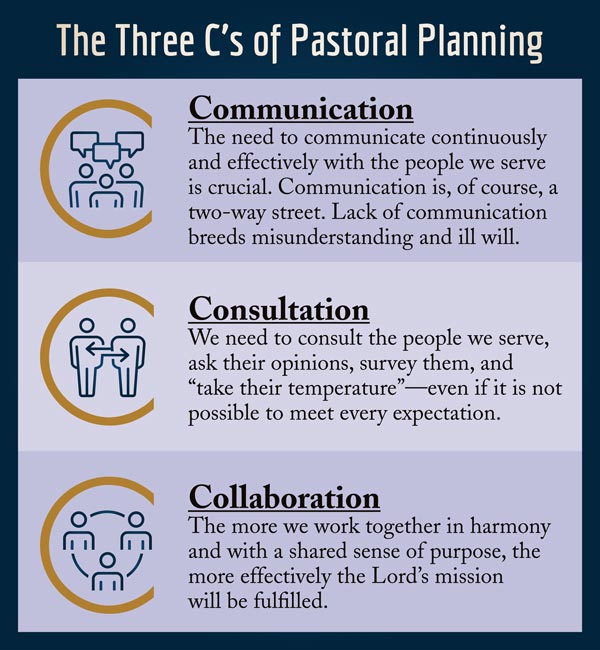
Every Layperson
As I mentioned earlier, too often, the task of evangelization is left to the so-called experts, but the authentic renewal of our parishes demands the engagement of every layperson. In 2012, building on the theology of the Second Vatican Council, Pope Benedict XVI made an extraordinary statement: “Co-responsibility demands a change in mindset especially concerning the role of lay people in the Church. They should not be regarded as “collaborators” of the clergy, but, rather, as people who are really “co-responsible” for the Church’s being and acting.”7 Much can be made of this point, both practically and theologically,8 but the central point is that the laity, precisely as the laity, play a unique and irreplaceable role in the life and mission of the Church. Far from passive recipients of the sacraments, the laity are baptized and sent into the world as priests, prophets, and kings.9 Thus, every member of the Church is to welcome the light of Christ and to radiate that light in every circumstance.10
What is more, an honest assessment of the Church today will find that some of the most effective evangelization efforts are lay-led and operate beyond officially sponsored church ministries. Such ministries, however, do not operate in a vacuum, but rather seek to engage parish communities to help them become more vibrant by cherishing and making use of the specific gifts of each layperson.11 Whether or not any given parish participates in such efforts, every parish should create an environment of support that invites parishioners to discern their gifts and to put them generously at the service of the Church. So too, we should be tireless in encouraging person-to-person, evangelization efforts.12 In these ways, we become co-responsible for the Church’s mission of evangelization.
A concrete example of such co-responsibility is the recently re-established Archdiocesan Pastoral Council, with representatives from around the Archdiocese, and upon whom I rely for continued guidance. Further, as I travel around the Archdiocese, it is clear to me that the Holy Spirit is generous in distributing spiritual gifts among our parishioners. At the same time, we need to have the boldness to beg the Spirit for a continued outpouring of gifts and for the wisdom to employ them well and wisely. Much work remains to be done but let us be clear: it is only in the communion with Christ and one another (koinonia) that the work of evangelizing is accomplished.
Further Dimensions of Parish Ministry
As we enter more deeply into this pastoral planning process, newly emerging imperatives in our mission have come more clearly into focus. Among these are: 1) the importance of sound evangelization and catechesis; 2) the need to combat racism; 3) the growth of the Latino community in our midst; 4) the need to evangelize younger Catholics and disaffected Catholics; 5) the practice of a charity that bears witness to Christ.
First, I want to highlight the importance of sound evangelization and catechesis. In light of the new Directory for Catechesis and other documents from the magisterium of Pope Francis, it is time we take a good look at our parish programs of faith formation, including preparation for the Sacraments of Initiation, and other forms of evangelization and catechesis. Despite our best efforts, in many instances, we have catechized but not effectively evangelized the faithful. Evangelization and catechesis are both essential and interconnected but distinct.13 We should not hesitate to ask which approaches are effective and which are not. Instead of watering down our message and our teaching, let us consider how we can present a more ample picture of the truth and beauty of the Church’s faith, worship, and service to our young people, to their parents, and to young adults. We need to ask how many of those who receive First Penance and First Holy Communion and Confirmation actually continue to practice their faith. Relying on God’s grace poured out upon us in prayer, we need to tap into the best practices and resources available to help us minister as effectively as possible to the families and young people entrusted to our care.
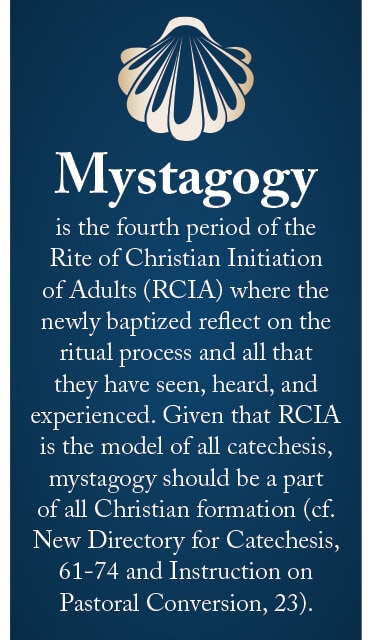 In this connection, let me add a word about the Rite of Christian Initiation of Adults. Each year, a goodly number of adults enter the Church. Some are catechumens, unbaptized men and women seeking to become one with Christ and one with the Church. Others are already baptized but are seeking full communion with the Church. While we rejoice that they present themselves for initiation, we are also concerned that many, seemingly, do not persevere in the faith. This raises the question of whether they are truly evangelized and catechized, and what sort of follow up (mystagogy) is provided for them. We have only to think of the lengths to which companies go to keep their newfound customers to get some idea of how challenging it is to retain those whom we have initiated.
In this connection, let me add a word about the Rite of Christian Initiation of Adults. Each year, a goodly number of adults enter the Church. Some are catechumens, unbaptized men and women seeking to become one with Christ and one with the Church. Others are already baptized but are seeking full communion with the Church. While we rejoice that they present themselves for initiation, we are also concerned that many, seemingly, do not persevere in the faith. This raises the question of whether they are truly evangelized and catechized, and what sort of follow up (mystagogy) is provided for them. We have only to think of the lengths to which companies go to keep their newfound customers to get some idea of how challenging it is to retain those whom we have initiated.
While we are on the subject of Christian formation, I would like to add a word about the role our Catholic schools play in evangelizing and catechizing young people and their families. Our Catholic schools play an indispensable role in helping parents to bring their children up in the faith; indeed, our schools serve as partners with parents in fulfilling their responsibility as “the first teachers of their children in the ways of faith” (Rite of Baptism). Yet, the schools face ever-greater challenges in this regard. Some parents send their children to Catholic schools but do not bring them to Mass on Sunday, nor do they reinforce at home the faith that is taught in school. Further, a goodly number of the children whom we educate are not Catholic, and while we ought not proselytize, they too should have an opportunity to encounter the light of Christ during their education. There is also a need for an ever-stronger partnership of parishes and schools to reach out to all the school parents. Together, we need to do our best to evangelize and catechize them, to help them see that it is in their best interests and the best interests of their children, to make their homes sanctuaries of love and life, places of prayer. As noted earlier, it is in our homes where young people are formed in the faith and in the virtues that will shape their futures, in this world and in the next.
Second, if we truly hope to evangelize, that is, to extend the Gospel message to every person within our parishes, then we must cleanse our communities of every vestige of racism. This is something we must do, not because it is in vogue or because there has been unrest in our streets, but rather, because Jesus Christ has revealed the inviolable dignity of each person and he calls us to foster the common good both in our Church and in the wider society.
The Archdiocese has taken a number of steps in this regard. Two years ago, I issued a pastoral letter titled Journey to Racial Justice. That letter outlined steps which we, as an Archdiocese, need to take in coming to terms with the Church’s involvement in slavery and Jim Crow, and with the latent racism that persists in our midst even to this day. Often, racist attitudes lodge themselves in our minds and hearts without our being fully aware of them. Now is the time for us to dislodge those attitudes so that we might reflect more fully the light and love of our Savior and exemplify the racial justice we wish to see in the civic community.
With that in mind, I assembled a Racial Justice Working Group that is developing a strategic plan to root out racism, a plan that hinges on the authentic conversion of our hearts as individuals and as a Church community. Currently, the Working Group is making proposals to the Archdiocese and to our parish communities concerning changes in policies and practices that will enable the Church better to reflect its teaching on human dignity and the common good. I wish to offer a word of thanks to the members of the Working Group and also to Black Catholics throughout the Archdiocese for sharing your gifts, your culture, and indeed, for challenging this local church to do better.
Among the many lessons already learned is this: even though our parish communities tend to be diverse, we should not take it for granted that everyone feels welcome. In the next section of this pastoral letter, I will revisit the core mission priority of hospitality. If a parish takes radical hospitality seriously, then it will leave no room for any form of racial discrimination and will make it abundantly clear that people of every race and ethnic origin are truly welcome and invited to participate fully in parish activities and ministries.
A third phenomenon is the rapid growth of Latino communities. The Archdiocese of Baltimore has a rich history of different cultural expressions of Catholicism, and our Hispanic sisters and brothers are no exception. In almost every sector of the Archdiocese, the number of Latino Catholics is increasing rapidly. Parishes that historically did not have substantial numbers of Latinos could well find that this has changed. Accordingly, more and more parishes will need to welcome our brothers and sisters in Christ as a part of the community by providing, to the extent possible, a robust Hispanic ministry. This is more than offering Holy Mass in Spanish. It also entails offering other services and ministries in Spanish and in a manner that respects the unique gifts that the Hispanic cultures bring to our local Church. Here I want to offer a special word of encouragement and thanks to my Latino brothers and sisters in the faith. Your increasing presence and your spiritual gifts are a great blessing that strengthens the life of the whole Archdiocese.
A fourth and very important dimension of parish missionary activity is outreach to disaffected Catholics, as well as to Millennials and Gen Z Catholics. Sadly, a majority of baptized Catholics no longer practice the faith with regularity. Indeed, numerous studies published by the Center for Applied Research in the Apostolate (CARA) and the Pew Research Center make for depressing reading. Mention has already been made of reasons for disaffection among many Catholics, including scandalous behavior on the part of Church leaders and confusion about the Church’s teachings and mission. Other Catholics stopped practicing because their faith was not deeply rooted or because of the pull of the culture or because of simple ennui. Surprisingly, however, more than a few of these Catholics are simply waiting for an invitation to return, to “come and see” (Jn 1:39). Others may find the personal witness of fellow lay Catholics convincing. Still others may simply want a friendly, non-defensive hearing of their difficulties and complaints. This is hard work, and it requires teamwork on the part of clergy and laity, coupled with persevering prayer.
There is much to say about attracting Millennials and Gen Z Catholics to the faith. Many of these Catholics grew up in households where the practice of the faith was tenuous at best. Yet I also speak with many parents who certainly did their best and anxiously pray for and await their child’s return to Church. Unfortunately, many young people came of age in a culture and a secular educational system that sometimes ignores or misrepresents the Church’s history, teaching, and cultural contributions. Further, younger generations came of age in a culture that, in many respects, is not open to the value of religious faith. That said, however, it would be a mistake to underestimate the openness of young people to authenticity or their search for meaning or their desire to make a difference in society. Put another way, there is more common ground between the Church and today’s youth than often may be thought. We need to find and establish this common ground and tap into the gifts God has entrusted to younger generations.14
This requires that we pay close attention to the young people who still frequent our parishes. As Pope Francis said, “A Church always on the defensive, which loses her humility and stops listening to others, which leaves no room for questions, loses her youth and turns into a museum.”15 We need to build up bonds of trust and offer faith-formation opportunities, coupled with outlets to serve the poor and vulnerable. Along the way, we need to facilitate ongoing conversion and moments to encounter the Lord Jesus. We also need to equip young adults to bear witness to other young people to Christ, “the power and wisdom of God” (1 Cor 1:24) and to the truth and goodness of the faith. Put simply, my young adult readers, we are listening and desire to walk together on this path toward the full beauty of the Church’s life of worship.
Let me mention a further imperative, namely, the engagement of each parish community in various forms of hands-on charitable ministry to the sick, the impoverished, and the vulnerable.16 Many, if not most, parishes already engage in such ministries of love and service. Others collaborate with Catholic Charities of Baltimore in its extensive programs of charitable and social services. During the current pandemic, various parishes have found ways to step up such ministries. For a moment, however, let us focus on their significance. In Matthew 25, Jesus reminds us that what we do for “the least of these,” we do for him. Jesus has identified himself with those whom the world so often disregards. Further, Pope Francis has lifted up for the whole Church the figure of the Good Samaritan.17 He has taught us to see Jesus as the Good Samaritan who stops on the road of life to tend to those in need. From these two vantage points, we can thus see that as parish communities perform ministries of charity and service on behalf of those in need, these communities are indeed bearing witness to Christ. Thus did St. John Paul II speak of “a charity that evangelizes,” a charity that bears witness to our belief in Christ.18
Before I conclude this section, let me add a further observation. If a parish is “a family of families” (as observed above), then the Archdiocese is a family of parishes. The point I want to emphasize here is the same one that the Second Vatican Council stressed, namely, the Church is a communion.19 In the rough and tumble of parish life, it can be easy for a parish team to become competitive – vis à vis neighboring parishes and indeed the Archdiocese as such and vice-versa. Yet, only when we work together as a local church does the mission of evangelization truly succeed. For the very nature of the Church is to be a communion of persons rooted in the communion that is the Trinity.20 This means that we need to eliminate, as much as God’s grace makes possible, the “us-against-them” mentality that saps so much energy that, otherwise, we should use for mission. Especially in these challenging days, we need constantly to beseech the Holy Spirit to make us “one body, one spirit in Christ” (Eucharistic Prayer III)—a communion of life and love through which the light of Christ shines brightly, not just here or there, but throughout the City of Baltimore and the nine counties of Maryland that comprise the Archdiocese. What’s more, as the light of Christ shines brightly in our Archdiocese, we strengthen the Church universal of which the Archdiocese is a uniquely local incarnation.21
New Evangelization Institute
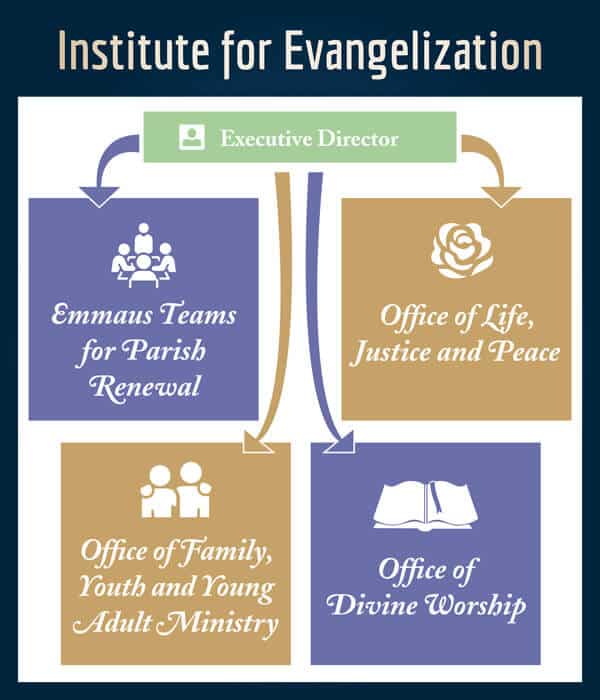 It is for all these dimensions and more that I have decided to create an Institute for Evangelization. Far from a mere collection of ministries – as important as they all may be – this Institute will exist fundamentally to enliven the evangelizing work of the local Church. Evangelization is about relationships and relationship-building will be precisely the Institute’s work. To this end, the Institute will consist of four components: Emmaus Teams; the Office of Family, Youth, and Young Adult Ministry; the Office of Divine Worship; and the Office of Life, Justice and Peace. The concept of the “Emmaus Teams” is quite novel but not without Biblical foundations. The episode of the disciples on the road to Emmaus has for many become the model of accompaniment and with good reason. The Lord comes into their midst and walks together with them (cf. Lk 24:13-35), and the Lord doesn’t send us out to do this work alone, he sends us two-by-two. (Cf. Mk 6:7; Lk 10:1) This “team” will then operate as a team of teams, each one consisting of a coach who specializes in organizational health and another who will have a great expertise in the art of evangelization. Each pastorate will have an Emmaus Team readily available to support its evangelizing efforts and strengthen their leadership team. The other offices will work closely with the Emmaus Teams to ensure their work and offerings are always at the support of the pastorates. The Family Ministry Office will identify the best manner to support all families, especially working to close any perceived or real gaps between parishes and schools that operate on the same campuses. The Office of Divine Worship will reinforce our continued commitment to the priority of vibrant liturgies. Lastly, the Office of Life, Justice and Peace will bring together ministries that support the Church’s efforts to realize the common good. Specifically, this office will focus on efforts that are best supported Archdiocesan-wide, everything from post-abortion healing retreats, to ministry to those imprisoned, to Camp GLOW, all the while working in close collaboration with Catholic Charities, Catholic Relief Services and the Maryland Catholic Conference to engage parishioners and pastorates in these efforts.
It is for all these dimensions and more that I have decided to create an Institute for Evangelization. Far from a mere collection of ministries – as important as they all may be – this Institute will exist fundamentally to enliven the evangelizing work of the local Church. Evangelization is about relationships and relationship-building will be precisely the Institute’s work. To this end, the Institute will consist of four components: Emmaus Teams; the Office of Family, Youth, and Young Adult Ministry; the Office of Divine Worship; and the Office of Life, Justice and Peace. The concept of the “Emmaus Teams” is quite novel but not without Biblical foundations. The episode of the disciples on the road to Emmaus has for many become the model of accompaniment and with good reason. The Lord comes into their midst and walks together with them (cf. Lk 24:13-35), and the Lord doesn’t send us out to do this work alone, he sends us two-by-two. (Cf. Mk 6:7; Lk 10:1) This “team” will then operate as a team of teams, each one consisting of a coach who specializes in organizational health and another who will have a great expertise in the art of evangelization. Each pastorate will have an Emmaus Team readily available to support its evangelizing efforts and strengthen their leadership team. The other offices will work closely with the Emmaus Teams to ensure their work and offerings are always at the support of the pastorates. The Family Ministry Office will identify the best manner to support all families, especially working to close any perceived or real gaps between parishes and schools that operate on the same campuses. The Office of Divine Worship will reinforce our continued commitment to the priority of vibrant liturgies. Lastly, the Office of Life, Justice and Peace will bring together ministries that support the Church’s efforts to realize the common good. Specifically, this office will focus on efforts that are best supported Archdiocesan-wide, everything from post-abortion healing retreats, to ministry to those imprisoned, to Camp GLOW, all the while working in close collaboration with Catholic Charities, Catholic Relief Services and the Maryland Catholic Conference to engage parishioners and pastorates in these efforts.



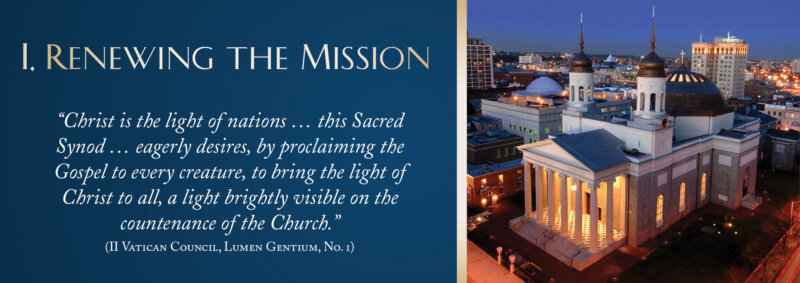
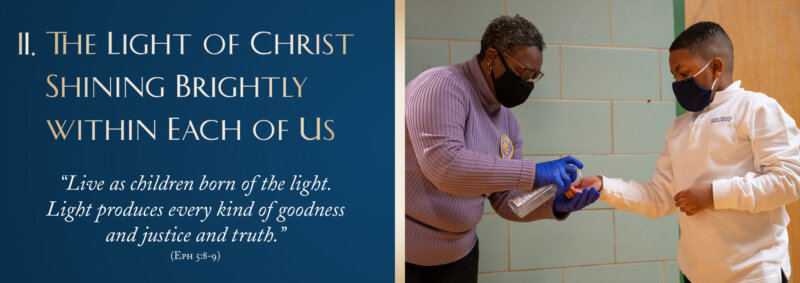
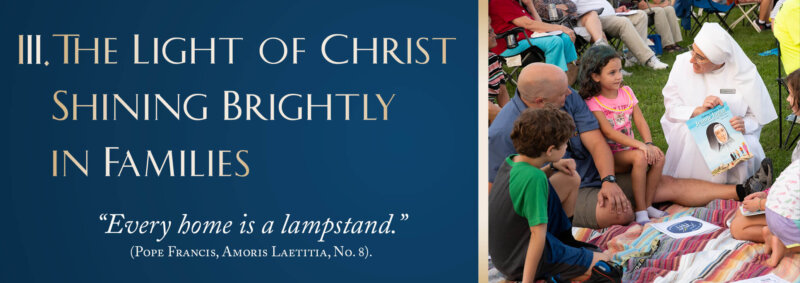
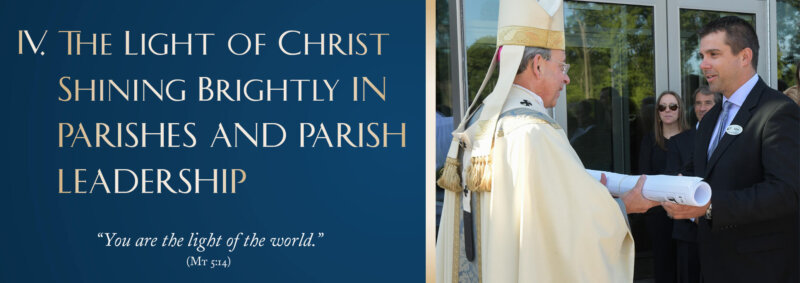
 Somewhere along the way, the practice of visiting the homes of parishioners seems to have largely fallen out of favor, perhaps because it is hard to find people at home or because there are fewer clergy than previously was the case. Yet, would it not be a wonderful thing if, every year, every parishioner—active or inactive—received a personal call or perhaps an invitation to a Zoom meeting? Indeed, the more we stay in touch with parishioners and communicate with them personally, the more likely it is that they remain or become active in the life and mission of the parish. True enough, in making personal contacts, some may give us an earful or otherwise rebuff our efforts. That is why we need a healthy life of prayer and that is why we need to support one another.
Somewhere along the way, the practice of visiting the homes of parishioners seems to have largely fallen out of favor, perhaps because it is hard to find people at home or because there are fewer clergy than previously was the case. Yet, would it not be a wonderful thing if, every year, every parishioner—active or inactive—received a personal call or perhaps an invitation to a Zoom meeting? Indeed, the more we stay in touch with parishioners and communicate with them personally, the more likely it is that they remain or become active in the life and mission of the parish. True enough, in making personal contacts, some may give us an earful or otherwise rebuff our efforts. That is why we need a healthy life of prayer and that is why we need to support one another.
 In this connection, let me add a word about the Rite of Christian Initiation of Adults. Each year, a goodly number of adults enter the Church. Some are catechumens, unbaptized men and women seeking to become one with Christ and one with the Church. Others are already baptized but are seeking full communion with the Church. While we rejoice that they present themselves for initiation, we are also concerned that many, seemingly, do not persevere in the faith. This raises the question of whether they are truly evangelized and catechized, and what sort of follow up (mystagogy) is provided for them. We have only to think of the lengths to which companies go to keep their newfound customers to get some idea of how challenging it is to retain those whom we have initiated.
In this connection, let me add a word about the Rite of Christian Initiation of Adults. Each year, a goodly number of adults enter the Church. Some are catechumens, unbaptized men and women seeking to become one with Christ and one with the Church. Others are already baptized but are seeking full communion with the Church. While we rejoice that they present themselves for initiation, we are also concerned that many, seemingly, do not persevere in the faith. This raises the question of whether they are truly evangelized and catechized, and what sort of follow up (mystagogy) is provided for them. We have only to think of the lengths to which companies go to keep their newfound customers to get some idea of how challenging it is to retain those whom we have initiated. It is for all these dimensions and more that I have decided to create an Institute for Evangelization. Far from a mere collection of ministries – as important as they all may be – this Institute will exist fundamentally to enliven the evangelizing work of the local Church. Evangelization is about relationships and relationship-building will be precisely the Institute’s work. To this end, the Institute will consist of four components: Emmaus Teams; the Office of Family, Youth, and Young Adult Ministry; the Office of Divine Worship; and the Office of Life, Justice and Peace. The concept of the “Emmaus Teams” is quite novel but not without Biblical foundations. The episode of the disciples on the road to Emmaus has for many become the model of accompaniment and with good reason. The Lord comes into their midst and walks together with them (cf. Lk 24:13-35), and the Lord doesn’t send us out to do this work alone, he sends us two-by-two. (Cf. Mk 6:7; Lk 10:1) This “team” will then operate as a team of teams, each one consisting of a coach who specializes in organizational health and another who will have a great expertise in the art of evangelization. Each pastorate will have an Emmaus Team readily available to support its evangelizing efforts and strengthen their leadership team. The other offices will work closely with the Emmaus Teams to ensure their work and offerings are always at the support of the pastorates. The Family Ministry Office will identify the best manner to support all families, especially working to close any perceived or real gaps between parishes and schools that operate on the same campuses. The Office of Divine Worship will reinforce our continued commitment to the priority of vibrant liturgies. Lastly, the Office of Life, Justice and Peace will bring together ministries that support the Church’s efforts to realize the common good. Specifically, this office will focus on efforts that are best supported Archdiocesan-wide, everything from post-abortion healing retreats, to ministry to those imprisoned, to Camp GLOW, all the while working in close collaboration with Catholic Charities, Catholic Relief Services and the Maryland Catholic Conference to engage parishioners and pastorates in these efforts.
It is for all these dimensions and more that I have decided to create an Institute for Evangelization. Far from a mere collection of ministries – as important as they all may be – this Institute will exist fundamentally to enliven the evangelizing work of the local Church. Evangelization is about relationships and relationship-building will be precisely the Institute’s work. To this end, the Institute will consist of four components: Emmaus Teams; the Office of Family, Youth, and Young Adult Ministry; the Office of Divine Worship; and the Office of Life, Justice and Peace. The concept of the “Emmaus Teams” is quite novel but not without Biblical foundations. The episode of the disciples on the road to Emmaus has for many become the model of accompaniment and with good reason. The Lord comes into their midst and walks together with them (cf. Lk 24:13-35), and the Lord doesn’t send us out to do this work alone, he sends us two-by-two. (Cf. Mk 6:7; Lk 10:1) This “team” will then operate as a team of teams, each one consisting of a coach who specializes in organizational health and another who will have a great expertise in the art of evangelization. Each pastorate will have an Emmaus Team readily available to support its evangelizing efforts and strengthen their leadership team. The other offices will work closely with the Emmaus Teams to ensure their work and offerings are always at the support of the pastorates. The Family Ministry Office will identify the best manner to support all families, especially working to close any perceived or real gaps between parishes and schools that operate on the same campuses. The Office of Divine Worship will reinforce our continued commitment to the priority of vibrant liturgies. Lastly, the Office of Life, Justice and Peace will bring together ministries that support the Church’s efforts to realize the common good. Specifically, this office will focus on efforts that are best supported Archdiocesan-wide, everything from post-abortion healing retreats, to ministry to those imprisoned, to Camp GLOW, all the while working in close collaboration with Catholic Charities, Catholic Relief Services and the Maryland Catholic Conference to engage parishioners and pastorates in these efforts.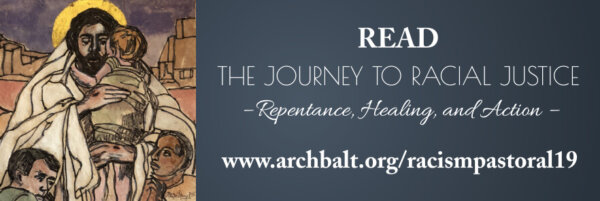
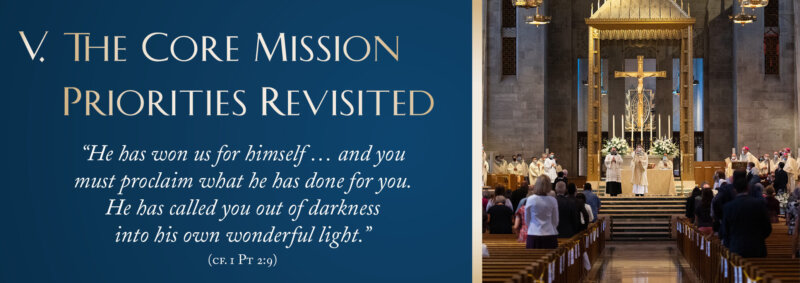
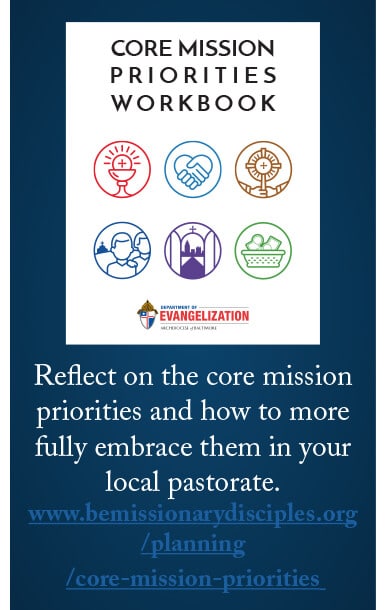 First is the celebration of the liturgy, especially the Eucharistic liturgy. The Eucharist is the heart of every parish. In proclaiming the Word, in entering into Jesus’ sacrifice of love, his death and resurrection, and in receiving the Body and Blood of the Savior, given for us, parish communities are bound together in mutual and self-giving love. Elsewhere the liturgy is described as “the sun in the sky” without which the vine, that is, the Church, “cannot take root, grow, or bear fruit.” How the liturgy is celebrated in our parishes matters a great deal. For most Catholics, Sunday Mass is the point of contact with the Church. Thoughtful preaching, beautiful liturgical music, reverence for the Body and Blood of the Lord, and reverence for one another attract and impact God’s People. Each parish needs to undergo a liturgical examination of conscience, understanding that what may have seemed contemporary or relevant years ago, may now have become threadbare or even meaningless to people today. Does our celebration of the liturgy help to form, make, and send forth missionary disciples? Does it help our people to live the Christian life? Does it lift them up from the concerns of daily life and help them participate in the timeless liturgy of heaven? Does it make people want to return week after week?
First is the celebration of the liturgy, especially the Eucharistic liturgy. The Eucharist is the heart of every parish. In proclaiming the Word, in entering into Jesus’ sacrifice of love, his death and resurrection, and in receiving the Body and Blood of the Savior, given for us, parish communities are bound together in mutual and self-giving love. Elsewhere the liturgy is described as “the sun in the sky” without which the vine, that is, the Church, “cannot take root, grow, or bear fruit.” How the liturgy is celebrated in our parishes matters a great deal. For most Catholics, Sunday Mass is the point of contact with the Church. Thoughtful preaching, beautiful liturgical music, reverence for the Body and Blood of the Lord, and reverence for one another attract and impact God’s People. Each parish needs to undergo a liturgical examination of conscience, understanding that what may have seemed contemporary or relevant years ago, may now have become threadbare or even meaningless to people today. Does our celebration of the liturgy help to form, make, and send forth missionary disciples? Does it help our people to live the Christian life? Does it lift them up from the concerns of daily life and help them participate in the timeless liturgy of heaven? Does it make people want to return week after week?